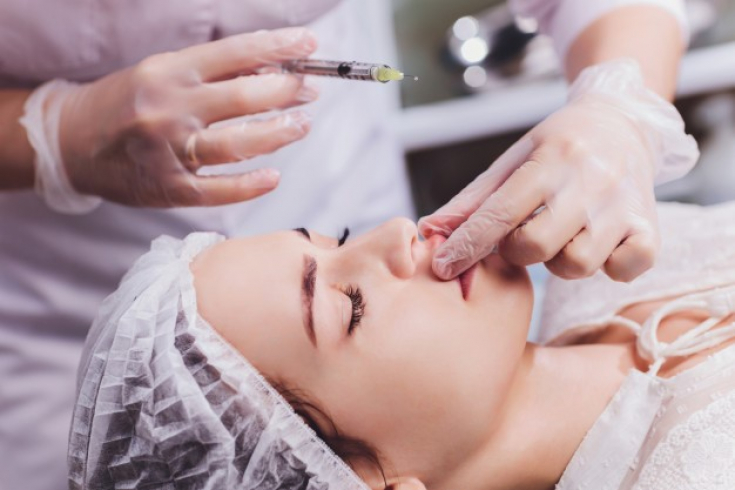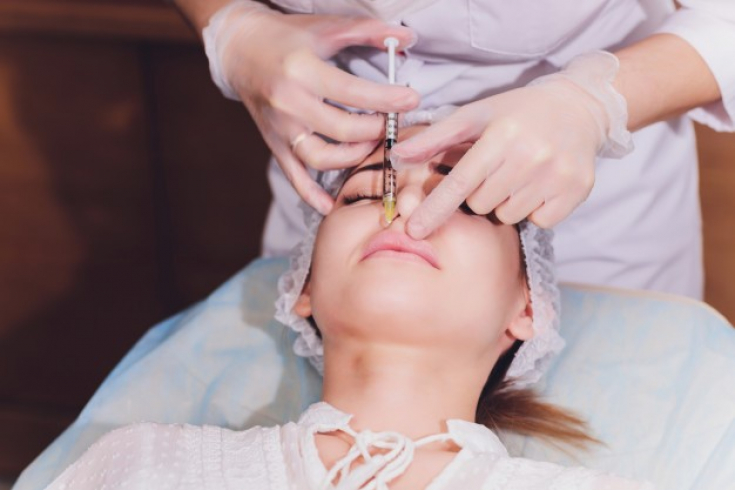Lip correction with filler – Undoubtedly, one of the most popular requests of the patient is a cosmetologist. Add volume, correct asymmetries, and balance lip proportions with a fast, minimally invasive, low-downtime lip contouring procedure. But after filler injections into the lip area, patients often report adverse events to the doctor, such as swelling, sensitivity, erythema, discoloration of the skin, the presence of seals, etc. They can occur immediately or some time after the injection of drugs. The article estet-portal.com will discuss methods for prevention and treatment of immediate, early and late complications of lip correction with fillers.
- How to prevent complications after lip fillers
- Possible side effects after lip correction with fillers
- Immediate complications of lip contouring
- Early complications of lip injections
- Late complications of lip fillers
How to prevent complications after lip fillers
First of all, before the procedure, the doctor is obliged to inform the patient about all potential adverse events that may occur after lip correction with fillers.
Before the procedure it is recommended:
- at least 3 days in advance, if possible, stop taking anti-inflammatory or blood-thinning drugs;
- avoid strenuous exercise for about 2 hours.
It is also suspected that sinusitis or dental procedures that occurred shortly before lip contouring may increase the risk of biofilm formation or delayed hypersensitivity reactions.
Successful lip correction largely depends on the correct choice of the product and the technique of administration of the drug, which also significantly affects the final result and duration of the effect of the procedure.
To obtain optimal results and ensure patient safety and comfort, the practitioner must follow the correct injection protocol exactly.
Of course, knowledge in the field of anatomy – an essential condition, without which it is impossible to contour plastic surgery.
Possible side effects after lip correction with fillers
In the vast majority of cases, patients tolerate injection lip correction well. Patients report predominantly mild discomfort during the procedure. Expected side effects may occur after any dermal filler. During the consultation, the doctor should warn the patient about possible adverse events associated with the injection procedure, which may occur immediately or after some time. Depending on this factor, complications are distinguished:
Immediate complications of lip contouring
Erythema
Erythema may persist for 1–2 hours depending on the product administered, the depth of injection, and the patient's response to the procedure. The patient can hide the redness after the injection site has healed with makeup.
Swelling
Swelling may persist for 2-12 hours depending on the filler injected and the amount of filler used. Hyaluronic acid fillers lead to more pronounced puffiness of the lips, which is due to the ability of HA to bind water. Patients may use cold compresses after the procedure to reduce swelling.
Read also: Swelling after filler: why it appears, who is to blame and what to do
Injection site tenderness
If localized lip tenderness occurs at the injection site, patients may take over-the-counter pain medications as needed. In the event of increased discomfort, swelling or spread of redness, the doctor should be informed. The patient may also experience vasovagal syncope due to discomfort or stress from the procedure.

Ecchymosis
Appearance of hemorrhages in soft tissues after injections of fillers in the lips – a frequent occurrence. To minimize the risk of ecchymosis, discontinue use approximately 3-7 days prior to injections:
- aspirin;
- anti-inflammatory drugs;
- platelet inhibitors;
- anticoagulants;
- vitamin E;
- Ginkgo Biloba;
- other herbal preparations.
An injector can also reduce the chance of bruising by replacing blunt or deformed needles in a timely manner.
Effect Tyndall
Incorrect, too superficial injection of hyaluronic acid leads to the appearance of a blue-gray skin tone. As a therapy, injections of hyaluronidase or manual extraction of the filler are used. Proper product selection also serves to prevent this complication.
Read also: Tyndall effect after hyaluronic acid fillers: recommendations of the expert group
Arterial damage
A vascular complication, including in the area of the lips, be caused by occlusion, compression or injury of a blood vessel. Deep knowledge of the vascular anatomy of the lips, control of the placement of the needle or cannula and observation of changes in skin color during insertion – basic rules for the prevention and timely response to a serious complication. If the patient suddenly feels pain, the filler injection should be interrupted immediately and the injection site checked for skin blanching.
Slow low pressure injection – a safer and more comfortable mode of filler injection.
Early symptoms of arterial occlusion:
- sudden pain;
- blanching of the skin, followed by darkening of the tissue, on which a mesh or spotted pattern appears.
Occlusion of the central retinal artery, resulting in loss of vision, may occur after injection of the product into the facial artery, resulting in CAS embolization.
Early complications of injection lip correction
Angioneurotic edema
This complication after lip fillers occurs because small blood vessels in the subcutaneous and/or submucosal tissues leak fluid through their walls, resulting in edema. Most often, AO is characterized by sharp and short-term swelling of the skin and mucous membranes, which can manifest itself in all parts of the body, but most often – around the eyes and lips.
In many cases, the swelling is self-limiting and resolves spontaneously within hours or days. In more severe cases, if persistent swelling is accompanied by itching or pain, medical attention is needed.
Recurrent herpes on lips
Patients with a history of herpesvirus infection are at risk of developing herpes after lip correction with fillers. The herpes virus is also located within the red border of the lips, which is also injected. Patients with chronic oral herpes infection or a case of it in the last 6 months before the procedure should take an antiviral drug for prophylaxis.
You may also be interested in: Herpes on the lips after cosmetic procedures: prevention and treatment
Vein injury
Venous occlusion does not cause severe pain or blanching of the affected area, but progresses slowly, leading to darkening of the problem area. Recommended therapy – 150 units hyaluronidase on an area of 1 x 1 cm2. High doses of hyaluronidase should be injected into the affected area every 15-30 minutes until the normal color is restored and the capillaries are filled.
Some HA products require higher doses of hyaluronidase. As a rule, such fillers are not intended for lip augmentation. The hyperbaric chamber has also been shown to improve the condition of patients, although there are no clinical studies to prove its effectiveness.
Non-inflammatory nodules
After injections of a filler into the lips, compacted formations may appear. They usually disappear after 1–2 weeks.
Possible causes of the complication:
- large volume of drug;
- too superficial introduction;
- uneven distribution of the filler in the lips.
Used as therapy:
- massage;
- manual deletion;
- hyaluronidase injections.
Fordyce granules can be mistaken for non-inflammatory nodules.
Late (delayed) complications of lip fillers
Inflammatory nodules/biofilms
Bacterial, fungal or viral infections after lip correction with fillers are extremely rare, but this possibility should not be ignored. Preliminary cleaning of the treated area with chlorhexidine or alcohol – the main method of preventing infections after contouring, including lips.
True infections are treated with oral antibiotics.
The granuloma often presents as an erythematous and/or indurated nodule that forms at the injection site and may persist for several weeks or months.

Clinically, foreign body granulomas appear as red papules, nodules, or plaques (with or without ulceration). The results of cultural examination of the material are negative. Due to fibrosis, the formations become denser over time. In this case, additional treatment may be needed, including antibiotics or intralesional injections.
True granuloma after injection of HA fillers – a rare occurrence.
After a filler is injected into the skin or subcutaneous tissue, the preparation may eventually become covered with bacteria that form a biofilm. These bacterial communities secrete a protective adhesive matrix that allows them to attach to living structures or inert surfaces, where they cause indolent, chronic antibiotic-resistant infections. Colichicine has been successfully used to treat delayed hypersensitivity reactions, but this has not been documented in the literature.
In order to prevent or minimize post-procedure complications, an injection physician performing lip fillers must use the products only as indicated, and also choose the correct injection techniques. Knowledge of the anatomy of the lip and around the mouth and careful examination also play an important role in the safety of contouring.
Adapted from Plastical Surgical Nursing.
Watch more useful videos on our channel at YouTube!







Add a comment